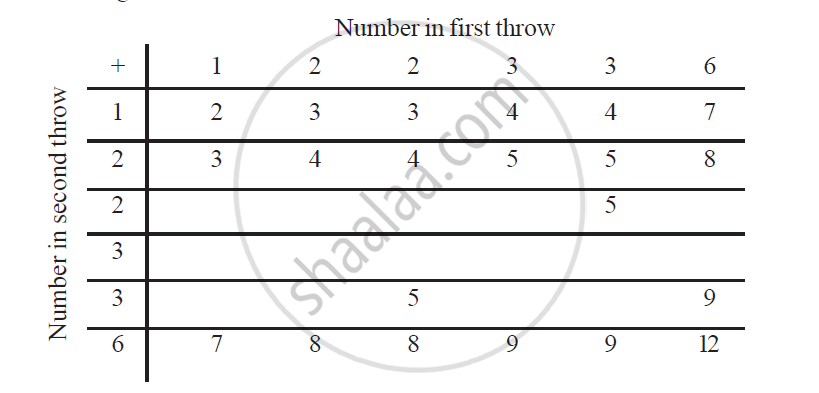Advertisements
Advertisements
Question
A die is thrown once. Find the probability of getting a prime number.
Solution
Total outcomes of throwing a die once are 1, 2, 3, 4, 5, and 6
Total number of possible outcomes = 6
Since 2, 3and 5 are prime numbers.
Favourable outcome = 3
P (probability) = `"Number of favourable outcomes"/"Total number of possible outcomes"`
= `3/6`
= `1/2`
RELATED QUESTIONS
If P(E) = 0.05, what is the probability of ‘not E’?
A die is numbered in such a way that its faces show the number 1, 2, 2, 3, 3, 6. It is thrown two times and the total score in two throws is noted. Complete the following table which gives a few values of the total score on the two throws:

What is the probability that the total score is
(i) even? (ii) 6? (iii) at least 6?
A die is thrown once. Find the probability of getting an odd number.
An urn contains 10 red and 8 white balls. One ball is drawn at random. Find the probability
that the ball drawn is white.
A bag contains 3 red balls, 5 black balls and 4 white balls. A ball is drawn at random from the bag. What is the probability that the ball drawn is White
Two customers are visiting a particular shop in the same week (Monday to Saturday). Each is equally likely to visit the shop on any one day as on another. What is the probability that both will visit the shop on different days?
Suppose the pen drawn in (i) is defective and is not replaced. Now one more pen is drawn at random from the rest. What is the probability that this pen is:
- defective
- not defective?
A bag contains 100 identical marble stones which are numbered 1 to 100. If one stone is drawn at random from the bag, find the probability that it bears a perfect square number.
Two dice are thrown simultaneously. What is the probability that:
- 4 will not come up either time?
- 4 will come up at least once?
In a game of chance, a spinning arrow comes to rest at one of the numbers 1, 2, 3, 4, 5, 6, 7, 8. All these are equally likely outcomes. Find the probability that it will rest at 8.

There are six cards in a box, each bearing a number from 0 to 5. Find the probability of the following event, that a card drawn show, a natural number.
Cards, marked with numbers 5 to 50, are placed in a box and mixed thoroughly. A card is drawn from the box at random. Find the probability that the number on the card is (i) a prime number less than 10 (ii) a perfect square.
A die is thrown 450 times and frequencies of the outcomes 1,2,3,4,5,6 were noted as given in the following table
| outcomes | 1 | 2 | 3 | 4 | 5 | 6 |
| Frequency | 73 | 70 | 74 | 75 | 80 | 78 |
(ii) a number < 4
A coin is tossed 100 times with the following frequency:
Head = 55, Tail = 45.
Find the probability of getting head.
Someone is asked to take a number from 1 to 100. The probability that it is a prime is ______.
A coin is tossed 3 times. List the possible outcomes. Find the probability of getting at least 2 heads
Two dice are thrown at the same time. Determine the probability that the difference of the numbers on the two dice is 2.
Following experiment have equally likely outcomes? Explain.
A baby is born. It is a boy or a girl.
In a lucky draw, there are 5 gifts and 25 blanks. The probability of getting a gift is ______.
